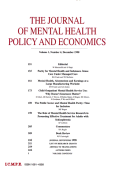Background: Considering the importance of depression and anxiety
disorders in the new century and one of the important causes of disability and
lost years worldwide and imposing a huge cost on the global economy, economic
burden studies to determine the location of costs and the consumption of
medical resources in recent years have contributed a lot to health
policymaking. During the studies, it was found that the prevalence of these
disorders increased significantly in Iran. This reason, along with the
difference in the results of studies on the economic burden of depression and
anxiety published in Iran in recent years, was one of the reasons for
conducting a study of the economic burden related to these disorders in the
East Azarbaijan province of Iran.
Method: A retrospective, non-interventional,
cross-sectional, social perspective study was conducted using a bottom-up
approach for direct costs and a human capital approach for indirect costs. The
data was collected from outpatients over the first four months of 2022 and from
inpatients over the first nine months of the same year. Patients without age
limits and suffering from at least one major depressive disorder (F32.0-F33.9),
panic anxiety (F41.0), and generalized anxiety disorder (F41.1) and natives of
East Azerbaijan province were included in the study. In the study for direct
costs, the cost of measures that are paid directly in the process of diagnosis
and treatment (medical and non-medical) were examined separately for
outpatients and inpatients. For indirect costs, lost productivity due to
absenteeism and premature death was calculated. For outpatients, a researcher’s
fee checklist form was made, and for the data of inpatients, the financial
statement available in the medical file of the hospital’s accounting system was
used. Razi Tabriz and Imam Khomeini Benab hospitals and mental health centers
of Tabriz were used as public centers, and specialist psychiatrists’ offices of
Tabriz were used as private centers. Patients with more than one comorbidity
were excluded from the study. Total costs are reported at purchasing power
parity rates.
Results: The data of 145 outpatients and 198
inpatients were analyzed to calculate the economic burden of MDD, Panic
Anxiety, and GAD. The total economic burden for these disorders was obtained by
142.2 million purchasing power parity (ppp) dollars in 2022 for the East
Azarbaijan province of Iran, with a population of more than 3.5 million people.
The economic burden was divided into direct costs of 35.4 million dollars ppp
and indirect costs of 106.79 million dollars ppp, representing 24.9% and 75.1%,
respectively. The share of direct expenses of the outpatient group is 23.1% of
this percentage, and the remaining 1.8% is for the inpatient group. In the case
of indirect cost, from the percentage related to this sector, the share of lost
productivity due to lost working days is 65.84%, and 9.26% is lost productivity
due to premature death. For the outpatient group, the cost of medicine with
58.64% of the cost per person, and in the inpatient group, the cost of patient
hoteling with 55.63%, and the visit of a psychiatrist with 20.34% of the direct
cost per hospitalized person, the largest share of the direct costs of these
people they assigned themselves. According to the method adopted in the study,
the total cost showed the highest sensitivity to the GDP Per Capita (ppp) and
the prevalence rate of anxiety and the prevalence rate of depression,
respectively.
Conclusion: Based on the results of the study, it
is clear that indirect costs account for a significant share of the economic
burden. Also, although the direct costs per inpatient are higher than the
direct costs per outpatient, due to the difference in the number of outpatients
and inpatients, the direct costs of the outpatient group have a larger share of
the total cost of the disease. Considering the average age of patients and the
large age gap to retirement age, health policymakers should take necessary
measures to deal with and prevent the ever-increasing costs. |
